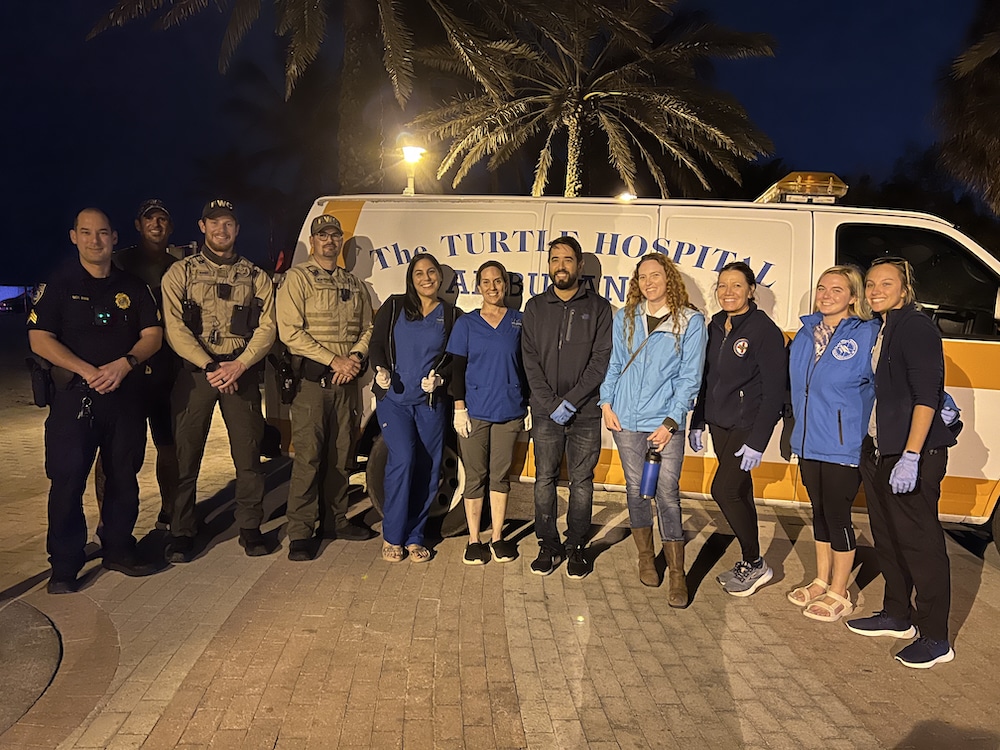“Mojo,” a 500+ pound leatherback sea turtle, stranded on Miami’s South Beach just before the new year. He’s estimated to be 30 to 35 years old.
According to NOAA, leatherback sea turtles are the largest turtles in the world. They’re the only species lacking scales and a hard shell and have existed in their current form since the age of dinosaurs. Their build allows them to dive deeper than most marine mammals – with the deepest recorded dive reaching nearly 4,000 feet. They’re highly migratory and can swim over 10,000 miles a year between their nesting and foraging grounds.

“Leatherbacks act as keystone species within the pelagic, or open ocean, ecosystem, as they control jellyfish populations,” said Callie Veelenturf, the founder and executive director of conservation organization The Leatherback Project.
“Jellyfish consume fish and fish larva, so sea turtles contribute to healthy ocean ecosystems and also support local fishing communities by controlling blooming jellyfish populations.” Veelenturf was not involved in Mojo’s rescue or rehabilitation.
Miami-Dade Sea Turtles responded to the emergency call for Mojo on Dec. 29. In an Instagram post, the conservation group detailed how the male sea turtle struggled in the shore break of Miami’s most famous beach.
Eventually, they brought him ashore for an initial assessment. In pictures, Mojo appears with wounds on his upper carapace and head. A capture shows the magnificent reptile staring at the lights of the big city.
View this post on Instagram
Mojo was transported via Turtle Ambulance to the Turtle Hospital in Marathon, Florida for further assessment and treatment. Manager Bette Zirkelbach told EcoWatch, “The best guess based on his condition is he suffered a severe entanglement, got himself free, got caught in the inshore current and then was not strong enough to swim back out through the surf.” He ended up beached on South Beach and eventually under Zirkelbach and her team’s care.

Unfortunately, this is a common challenge for leatherback sea turtles worldwide. Once prevalent in every ocean except the Arctic and Antarctic, leatherback populations are now in rapid decline, NOAA reported. The agency estimates that the global population has declined over 40 percent in the last three generations, with some nesting populations “essentially disappeared” and others “at risk of extinction.”
Florida’s Atlantic coast constitutes some of the main nesting areas for the Atlantic leatherback in the continental United States. However, “significant decreases in recent years” have also been observed in the sunshine state. See the Endangered Species Act’s 2020 Status Review for additional information on leatherback sea turtle abundance and population trends.
So, what’s taking down these “dinosaurs”? According to NOAA, the greatest threat to leatherbacks is becoming bycatch (incidental capture in fishing gear), hunting of sea turtles and collection of eggs for human consumption. Marine debris makes NOAA’s top five list of threats to leatherbacks, with entanglement in lost or derelict fishing gear leading to serious injuries, drownings and even death.
Veelenturf explained, “Sea turtles are air-breathing reptiles and can only hold their breath for up to 2 hours, so they are specifically susceptible to drowning via entanglement in fishing gear that is set for many hours at a time.” She launched several unrelated projects to combat fisheries bycatch of leatherback sea turtles but was not involved in this rescue.
Luckily for our sea turtle, the veterinary staff at The Turtle Hospital helped him get his mojo back. He received fluids, a long-acting, broad-spectrum antibiotic, vitamins and an anti-inflammatory. With treatment, he regained strength and passed his swim test. Leatherback sea turtles do not do well in captivity and often deteriorate in tank settings, Zirkelbach said. Therefore, when Mojo proved he could swim strong and dive as normal, he was cleared for release – just a few days after his rescue.

“We couldn’t have asked for a better outcome to end the year on!” Zirkelbach celebrated. “Mojo made a big splash returning to his ocean home in time for the New Year! Swim free, Mojo!
All sea turtle rescue and rehabilitation activities were conducted by authorized personnel under FWC marine turtle permits.

This article by Tiffany Duong was first published by EcoWatch on 19 January 2024. Lead Image: Mojo, an over 500-pound leatherback sea turtle, swims away into the Gulf Stream after rescue, rehabilitation and release. The Turtle Hospital.
What you can do
Help to save wildlife by donating as little as $1 – It only takes a minute.




![Hope, the Turtle Born with an Exposed Heart Beating Outside Her Body is Thriving Against All Odds [Video] Hope, the Turtle Born with an Exposed Heart Beating Outside Her Body is Thriving Against All Odds [Video]](https://i0.wp.com/www.onegreenplanet.org/wp-content/uploads/2020/08/screen-shot-2020-08-19-at-4-56-50-pm.png?fit=828%2C556&ssl=1)


Leave a Reply